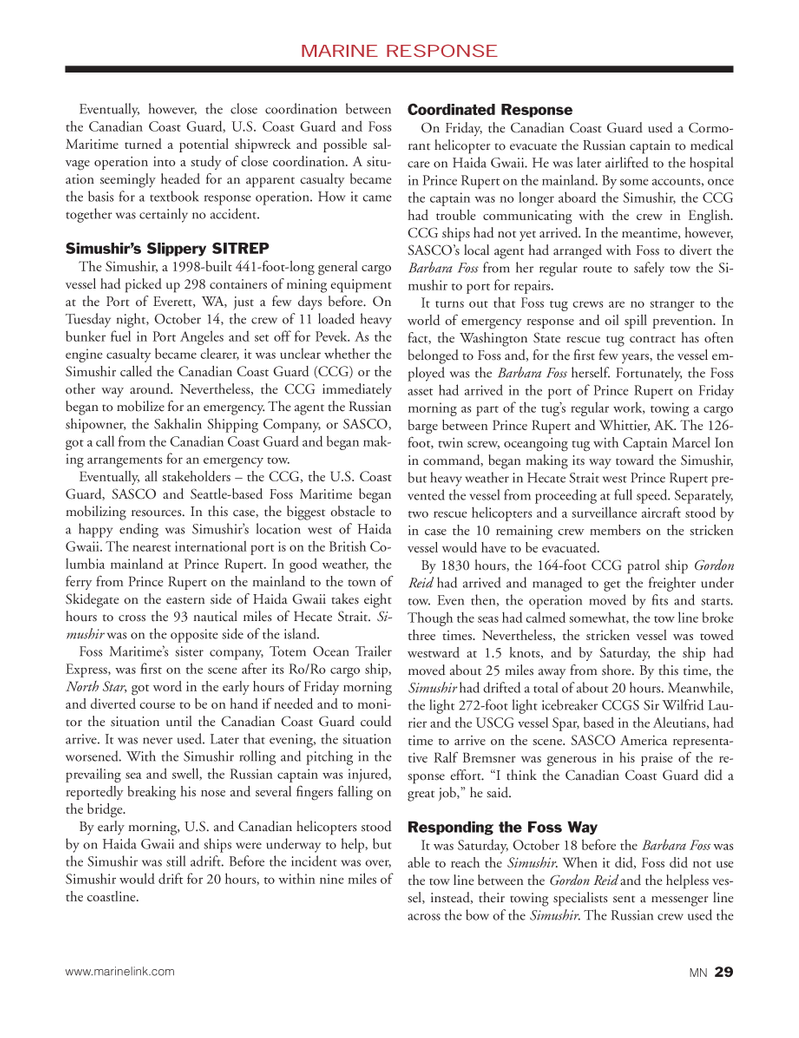
Page 29: of Marine News Magazine (December 2014)
Salvage & Spill Response
Read this page in Pdf, Flash or Html5 edition of December 2014 Marine News Magazine
MARINE RESPONSEEventually, however, the close coordination between the Canadian Coast Guard, U.S. Coast Guard and Foss Maritime turned a potential shipwreck and possible sal- vage operation into a study of close coordination. A situ- ation seemingly headed for an apparent casualty became the basis for a textbook response operation. How it came together was certainly no accident. Simushir?s Slippery SITREP The Simushir, a 1998-built 441-foot-long general cargo vessel had picked up 298 containers of mining equipment at the Port of Everett, WA, just a few days before. On Tuesday night, October 14, the crew of 11 loaded heavy bunker fuel in Port Angeles and set off for Pevek. As the engine casualty became clearer, it was unclear whether the Simushir called the Canadian Coast Guard (CCG) or the other way around. Nevertheless, the CCG immediately began to mobilize for an emergency. The agent the Russian shipowner, the Sakhalin Shipping Company, or SASCO, got a call from the Canadian Coast Guard and began mak- ing arrangements for an emergency tow. Eventually, all stakeholders ? the CCG, the U.S. Coast Guard, SASCO and Seattle-based Foss Maritime began mobilizing resources. In this case, the biggest obstacle to a happy ending was Simushir?s location west of Haida Gwaii. The nearest international port is on the British Co- lumbia mainland at Prince Rupert. In good weather, the ferry from Prince Rupert on the mainland to the town of Skidegate on the eastern side of Haida Gwaii takes eight hours to cross the 93 nautical miles of Hecate Strait. Si- mushir was on the opposite side of the island. Foss Maritime?s sister company, Totem Ocean Trailer Express, was rst on the scene after its Ro/Ro cargo ship, North Star , got word in the early hours of Friday morning and diverted course to be on hand if needed and to moni- tor the situation until the Canadian Coast Guard could arrive. It was never used. Later that evening, the situation worsened. With the Simushir rolling and pitching in the prevailing sea and swell, the Russian captain was injured, reportedly breaking his nose and several ngers falling on the bridge. By early morning, U.S. and Canadian helicopters stood by on Haida Gwaii and ships were underway to help, but the Simushir was still adrift. Before the incident was over, Simushir would drift for 20 hours, to within nine miles of the coastline. Coordinated Response On Friday, the Canadian Coast Guard used a Cormo- rant helicopter to evacuate the Russian captain to medical care on Haida Gwaii. He was later airlifted to the hospital in Prince Rupert on the mainland. By some accounts, once the captain was no longer aboard the Simushir, the CCG had trouble communicating with the crew in English. CCG ships had not yet arrived. In the meantime, however, SASCO?s local agent had arranged with Foss to divert the Barbara Foss from her regular route to safely tow the Si- mushir to port for repairs. It turns out that Foss tug crews are no stranger to the world of emergency response and oil spill prevention. In fact, the Washington State rescue tug contract has often belonged to Foss and, for the rst few years, the vessel em- ployed was the Barbara Foss herself. Fortunately, the Foss asset had arrived in the port of Prince Rupert on Friday morning as part of the tug?s regular work, towing a cargo barge between Prince Rupert and Whittier, AK. The 126- foot, twin screw, oceangoing tug with Captain Marcel Ion in command, began making its way toward the Simushir, but heavy weather in Hecate Strait west Prince Rupert pre- vented the vessel from proceeding at full speed. Separately, two rescue helicopters and a surveillance aircraft stood by in case the 10 remaining crew members on the stricken vessel would have to be evacuated. By 1830 hours, the 164-foot CCG patrol ship Gordon Reid had arrived and managed to get the freighter under tow. Even then, the operation moved by ts and starts. Though the seas had calmed somewhat, the tow line broke three times. Nevertheless, the stricken vessel was towed westward at 1.5 knots, and by Saturday, the ship had moved about 25 miles away from shore. By this time, the Simushir had drifted a total of about 20 hours. Meanwhile, the light 272-foot light icebreaker CCGS Sir Wilfrid Lau- rier and the USCG vessel Spar, based in the Aleutians, had time to arrive on the scene. SASCO America representa- tive Ralf Bremsner was generous in his praise of the re- sponse effort. ?I think the Canadian Coast Guard did a great job,? he said. Responding the Foss Way It was Saturday, October 18 before the Barbara Foss was able to reach the Simushir . When it did, Foss did not use the tow line between the Gordon Reid and the helpless ves- sel, instead, their towing specialists sent a messenger line across the bow of the Simushir . The Russian crew used the www.marinelink.com MN 29MN Dec14 Layout 18-31.indd 29MN Dec14 Layout 18-31.indd 2911/25/2014 10:23:29 AM11/25/2014 10:23:29 AM

 28
28

 30
30
